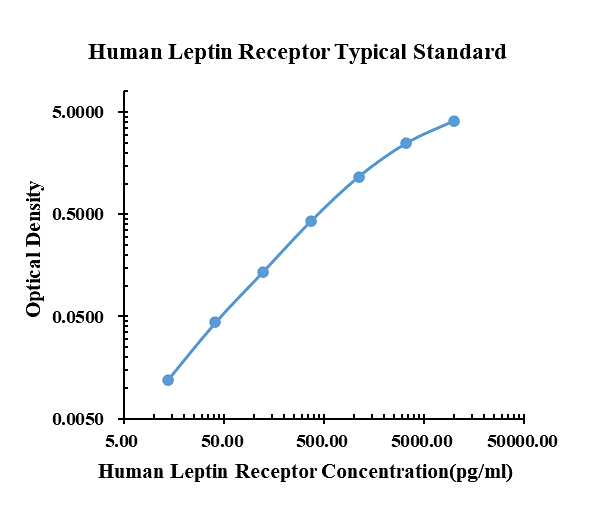Human Leptin Receptor enzyme-linked immunoassay kit
| Specification | 96 Test |
|---|---|
| Sensitivity | 0.90 pg/ml (50 μl);5.07 pg/ml (10 μl); |
| Standard Curve Range | 13.72~10000 pg/ml |
| Standard Curve Gradient | 7 Points/3 Folds |
| Number of Incubations | 2 |
| Detectable sample | Liquid phase sample of soluble substances. For example: serum, plasma, cell culture supernatant, tissue grinding liquid, etc. |
| Sample Volume | 50 μl/10 μl |
| Type | Fully Ready-to-Use |
| Operation Duration | 120min |

| pg/ml | O.D. | Average | Corrected | |
|---|---|---|---|---|
| 0.00 | 0.0088 | 0.0092 | 0.0090 | |
| 13.72 | 0.0208 | 0.0210 | 0.0209 | 0.0119 |
| 41.15 | 0.0539 | 0.0514 | 0.0527 | 0.0437 |
| 123.46 | 0.1480 | 0.1444 | 0.1462 | 0.1372 |
| 370.37 | 0.4646 | 0.4120 | 0.4383 | 0.4293 |
| 1111.11 | 1.1680 | 1.1840 | 1.1760 | 1.1670 |
| 3333.33 | 2.5250 | 2.4640 | 2.4945 | 2.4855 |
| 10000.00 | 4.1075 | 4.1126 | 4.1101 | 4.1011 |
Precision
| Intra-assay Precision | Inter-assay Precision | |||||
| Sample Number | S1 | S2 | S3 | S1 | S2 | S3 |
| 22 | 22 | 22 | 6 | 6 | 6 | |
| Average(pg/ml) | 272.7 | 915.8 | 3089.71 | 303.1 | 985.9 | 3109.3 |
| Standard Deviation | 13.9 | 42.7 | 174.51 | 11.4 | 46.1 | 189.2 |
| Coefficient of Variation(%) | 5.1 | 4.7 | 5.6 | 3.8 | 4.7 | 6.1 |
Intra-assay Precision (Precision within an assay) Three samples of known concentration were tested twenty times on one plate to assess intra-assay precision.
Inter-assay Precision (Precision between assays) Three samples of known concentration were tested six times on one plate to assess intra-assay precision.
Spike Recovery
The spike recovery was evaluated by spiking 3 levels of human Leptin Receptor into health human serum sample. The un-spiked serum was used as blank in this experiment.
The recovery ranged from 81% to 106% with an overall mean recovery of 93%.
Sample Values
| Sample Matrix | Sample Evaluated | Range (ng/ml) | Detectable (%) | Mean of Detectable (ng/ml) |
|---|---|---|---|---|
| Serum | 30 | 24.77-61.58 | 100 | 37.42 |
Serum/Plasma – Thirty samples from apparently healthy volunteers were evaluated for the presence of Leptin Receptor in this assay. No medical histories were available for the donors.
Product Data Sheet
Background: Leptin
Leptin receptor (OB-R), also named B219, is a type I cytokine receptor family protein with significant amino acid sequence identity with gp130, G-CSF receptor, and the LIF receptor. Multiple isoforms of human and mouse OB-R, including a long form (OB-RL) with a large cytoplasmic domain capable of signal-transduction, and several receptor isoforms with short cytoplasmic domains (OB-Rs) lacking signal-transducing capabilities, have been identified. The extracellular domains of the short and long forms of OB-R are identical. An OB-R transcript lacking a transmembrane domain and potentially encoding a soluble form of the receptor has also been described. Circulating soluble OB-R, complexed to leptin, has been detected in mouse serum. Serum soluble OB-R levels have been shown to increase during pregnancy. OB-RL transcripts were reported to be expressed predominantly in regions of the hypothalamus previously thought to be important in body weight regulation. Expression of OB-Rs transcripts have been found in multiple tissues, including the choroid plexus, lung, kidney and primitive hematopoietic cell populations. OB-R has recently been shown to be encoded by the mouse diabetes (db) and rat fatty (fa) genes. Rodents homozygous for the db or fa mutations have been known to exhibit an obesity phenotype.
Mouse OB-R long form encodes a 1162 amino acid (aa) residue precursor protein with a 22 aa residue signal peptide, an 817 aa residue extracellular domain, a 21 aa residue transmembrane domain, and a 302 aa residue cytoplasmic domain. The extracellular domain of OB-R contains two hemopoietin receptor domains, a fibronectin type III domain and the WSXWS domain. Recombinant murine soluble OB-R has been shown to bind leptin with high affinity and is a potent leptin antagonist.

